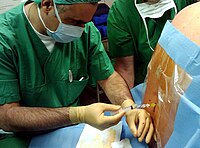
Photo from wikipedia
BACKGROUND Post-dural puncture headache following trauma to the dural membrane during neuraxial anaesthesia occurs in 0.13-6.5% of pregnant patients. Identifying factors beyond individual performance that contribute to this adverse event… Click to show full abstract
BACKGROUND Post-dural puncture headache following trauma to the dural membrane during neuraxial anaesthesia occurs in 0.13-6.5% of pregnant patients. Identifying factors beyond individual performance that contribute to this adverse event is crucial to developing improvement strategies. METHODS We used a root cause analysis framework, in a nested case-control study, to identify associated factors. Cases were all patients who had a post-dural puncture headache requiring an epidural blood patch. These patients were matched to a random group of control patients without post-dural puncture headache or known dural injury. Mixed logistic modelling was used. RESULTS Within a dataset of 35 763 patients, we selected all 154 patients with post-dural puncture headache and compared them with 616 controls. Migraine (odds ratio [OR] 10.60, 95% CI 2.74 to 41.05), obstetric and perinatal pathology (OR 10.85, 95% CI 4.29 to 21.42), and multiple insertion attempts (OR 11.48, 95% CI 6.29 to 20.94), increased the risk of post-dural puncture headache. In contrast, training >3 years (OR 0.20, 95% CI 0.55 to 0.76) and a nurse anaesthetist present during the procedure (OR 0.05, 95% CI 0.01 to 0.29) decreased the risk. The anaesthetist's identity, the size of the labour room, the timing of the procedure or workload did not modify the risk. CONCLUSION Post-dural puncture headache in this setting is not the result of the individual anaesthetist's characteristics alone. Additional factors including team composition, the presence of obstetrical perinatal pathology, and associated patient's conditions, are also associated with this event. Improvement strategies should consider all these factors.
Journal Title: International journal of obstetric anesthesia
Year Published: 2018
Link to full text (if available)
Share on Social Media: Sign Up to like & get
recommendations!